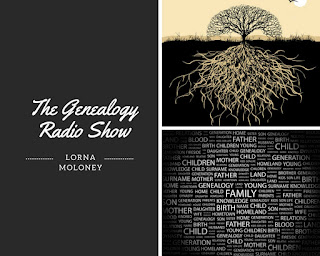Dissecting 89 George Street - A nineteenth century surgeon's residence in Limerick city - part 2.
89 O’Connell Street (named 89 George’s Street in the nineteenth century), a Georgian terraced town house, built c. 1840 for the purpose of housing wealthy, well-to-do members of Limerick’s gentry provides the origins of our research.[1] The functional design, generous living space, and multiple storeys incorporated into these townhouses attracted members of the professional class, facilitating the particular needs of physicians, apothecaries and other medical authorities in the growing urban centre in nineteenth-century Ireland.
The radio show Dissecting 89 George Street from Raidio Corcabaiscinn which aired on 3 March with Lauren Cassidy can be heard here at https://www.mixcloud.com/raidiocorcabaiscinn/genealogy-show-89-oconnell-street/
. From 1824 to 1915, there were 92 physicians, 24 apothecaries, 27 druggists, 24 chemists, 43 surgeons, one accoucheur (a male midwife) and 11 medical halls/ hospitals recorded in the Limerick commercial trade directories for George’s Street. The neighbouring townhouses surrounding 89 George’s Street all housed some medical services. In 1840, Philip Lyon, a physician lived at 90 George’s Street.[2] In the same year, Stanley Bouchier, an apothecary practiced his trade next door at 91 George’s Street.[3] From 1867-1870, James O’Shaughnessy, a medical doctor and surgeon offered his services at 88 George’s Street.[4] 86 George’s Street was home to the physicians William Keating in 1840, and Joseph Parker in 1856.[5] George’s Street’s past is embroiled with the history of medicine, offering medical officials a prestigious address, space for domestic life, as well as fitting rooms for offices, dispensaries and surgeries.
Taking 89 George’s Street as a house under investigation, “Dissecting 89 George’s Street: A Surgeon’s Life in Nineteenth Century Limerick City” talks explores the development of Newtown Pery and the construction of Georgian terraced townhouses in Limerick. The lives of individual residents like Dr James Tandy Wilkinson (a graduate of the Royal College of Surgeons) and Dr William Ringrose Gore (a medical doctor at Barrington’s Hospital, George’s Quay) bring fascinating research about nineteenth century Limerick city.
Dr William Ringrose Gore and his family residents of 89 George’s Street in 1846 ancestry originated with Gore, the eldest son of Sylvester Gore and Sarah Moore, marrying Elizabeth Wilson in 1834. [6] Gore and Elizabeth had three children, and two died at young ages. The eldest died as an infant, and the youngest at the age of 10 years and five months.
What adverse conditions could cause a surgeon’s children to die so young? Undoubtedly, the death of this doctor’s children reflected health and mortality in nineteenth-century Ireland. William Gore’s surgery and medical practices were startlingly different to what we are familiar with today. Germ theory had not been discovered, and many believed that disease was spread by wind-borne poisons known as ‘miasmas’. [7] Consequently, surgical equipment was commonly left unsterilized. There was no set uniform for doctors or surgeons, allowing those who practiced medicine to wear ordinary clothing. Surgical garments not routinely washed, and left-over blood and dirt proudly displayed hallmarks of professional skill. [8] No availability of anaesthetics meant surgical operations on conscious patients, in front of large audiences were common until the late nineteenth century,
During the Summer of 1832, Cholera ravaged the people of Limerick, baffling nineteenth-century physicians as to its cause and igniting widespread public hysteria. Cholera Morbus (Blue Cholera) 1831-1832, a related article states, ‘As Limerick prepared for the dreaded Cholera epidemic, it looked like snow in June…but it was slack lime spread on the streets in preparation for the deadly outbreak’.[9] It was a Limerick physician who contributed to the Cure for Cholera with O'Shaughnessy introducing life-saving intravenous fluid and electrolyte replacement therapy for the treatment of cholera. Dr William Brooke O’Shaughnessy was the son of the merchant Daniel O’Shaughnessy of Limerick.[10]
Our talks on the house history of 89 George’s Street explores the lives of the surgeons such as William Ringrose Gore, as well as the development of medical institutions in Limerick City, contemporary medical innovation, nineteenth-century medical practices, and the Cholera Epidemic of 1831-1832. Our talks will take place during the Lifelong Learning Festival Week.
Genealogy talks are scheduled for Tuesday the 19th of April, and Thursday the 21st of April.2016 at 2:30 pm at Innovate Limerick, the LEDP Boardroom on the Roxboro Road.
‘Dissecting 89 George’s Street: A Surgeon’s Life in Nineteenth Century Limerick City’ will take place on Wednesday, the 20th of April.
[1] Evening Echo, 89 O’Connell Street, Limerick, Limerick City,” National Inventory of Architectural Heritage, accessed February 19, 2016, http://www.buildingsofireland.ie/niah/search.jsp?type=record&county=LI®no=21517063.
[2] The New Triennial & Commercial Directory for the Years 1840, 41 & 42, of the Cities of Limerick, Waterford & Kilkenny, Together with the Tows of Clonmel, Carrick-on-Suir, New Ross and Carlow (Limerick: George Goggin, 1840), 64.
[3] The New Triennial & Commercial Directory for the Years 1840, 41 & 42, of the Cities of Limerick, Waterford & Kilkenny, Together with the Tows of Clonmel, Carrick-on-Suir, New Ross and Carlow (Limerick: George Goggin, 1840), 47.
[4] Henry & Coghlan’s General Directory of Cork for 1867 (Cork: Henry and Coghlan, 1867), 391 and Slater’s Royal National Commercial Directory of Ireland (London: Isaac Slater, 1870) 161..
[5] The New Triennial & Commercial Directory for the Years 1840, 41 & 42, of the Cities of Limerick, Waterford & Kilkenny, Together with the Tows of Clonmel, Carrick-on-Suir, New Ross and Carlow (Limerick: George Goggin, 1840), 64 and Slater’s Directory, 1856. (London: Isaac Slater, 1856), 310..
[6] Findmypast, search.findmypast.ie/bna/viewarticle?id=bl%2f0001425%2f18340503%2f043.
[7] David Lee and Bob Kelly (eds), Georgian Limerick, 1714-1845 (Limerick: Limerick Civic Trust, 1996), 154.
[8] “19th Century Medicine,” Findmypast, accessed Feb. 19, 2016, https://blog.findmypast.ie/19th-century-medicine-1406392208.html.
[9] “Cholera Morbus (Blue Cholera) 1831-1832,” Limerickcity.ie, accessed Feb. 22, 2016, http://www.limerickcity.ie/media/cah04.pdf.
[10] J. A. Bridge, “Sir William Brooke O’Shaughnessy, M.D., F.R.S., F.S.A..: A Biographical Appreciation by an Electrical Engineer,” Notes and Records of the Royal Society of London 52, no. 1 (1998) : 105.


Comments
Post a Comment